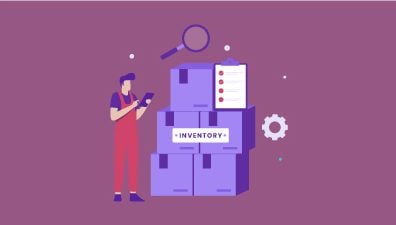Not having proper and appropriate inventory management techniques is one of the major challenges facing businesses, followed by a series of unpredictable consequences, such as loss of customers, revenue, and market share to the hands of competitors.
It’s a reality that many businesses are afraid of scaling. In part, they are too busy with their current business activities, so they don’t have much time to prepare in advance for the next steps. In another part, they fear the bigger challenges ahead could kill their burgeoning career. And one of such bigger difficulties preventing a business from expansion and growth is its poor ability to manage inventories.
It can seriously impact your customer base if you don’t supply them in a timely manner. In B2B business, it leads to a lack of trust and attachment, which creates a long-term relationship between the supplier and the seller.
In addition, as customers’ shopping habits are constantly changing, brands are growing to sell on multiple channels to meet their needs. Therefore, to easily manage and track product sold and stock balance across all these channels, inventory control methods and tools are needed like never before.
So what are the 3 major inventory management techniques? Which ones should you use for effectiveness? And how do they work?
All will be answered in detail in this article. Also, we promise to provide complete basic but essential knowledge about inventory management for those who are still not familiar with this concept.
Let’s explore now!

Table of Contents
- What are the inventory management techniques?
- 3 Major inventory management techniques and more
- Just-in-time (JIT) inventory
- ABC inventory analysis
- Dropshipping
- Economic order quantity (EOQ) model
- Bulk shipments
- Backordering
- Consignment
- Cross-docking
- Cycle counting
- Material requirements planning (MRP) method
- Minimum safety stocks
- VED (Vital Essential and Desirable) Analysis
- FSN (Fast, Slow & Non-moving) Method
- Set par levels
- First in, first out (FIFO)
- Manage relationships
- Contingency planning
- Batch tracking
- Accurate forecasting
- Last in, first out (LIFO)
- Safety stock
What are the inventory management techniques?
Goods come and go continuously. In order not to lose goods and build a perfect business apparatus, you will need to track and record the number of products in your hand, i.e., inventory. This work is collectively referred to as inventory management.
However, inventory management is not just about controlling inventory; but it is also about the balance with the original number of entries minus the number of goods sold. It is also influenced by customer demand, the raw materials and products provided by suppliers, etc. Thus, inventory management will include a set of tools and strategies for you to track, distribute, and arrange goods to suit the current business situation.
So, what are the inventory management techniques?
At a level higher than the balance of goods and the proper arrangement, distribution of goods in the warehouse, there are many inventory management techniques which are tools and methods helping you minimize warehouse costs and maximize profits.
Most small and medium companies are not aware of these techniques, so the profit they get is very small compared to those using them while other expenses are not small. Consequently, if you still do not fully believe in what inventory management techniques can do for your business, here are their detailed benefits:
- Reduce risks of overselling.
- Save costs.
- Measure product in the event of a recall better.
- Avoid stock-outs and stock excess.
- Improve business negotiations.
- Simplify inventory management.
- Make more profitable business decisions.
3 Major inventory management techniques and more
The 3 major inventory management techniques used by companies include Just-in-time inventory, ABC inventory analysis, and Dropshipping model. In addition, there are dozens of other methods for you to have a more diverse choice, from which to keep for yourself the one (or more) that is most suitable.
Just-in-time (JIT) inventory
In this approach, your company calculates so that the remaining inventory will be sufficient to supply customers until new stock is produced or resupplied. It helps reduce storage or insurance costs for unnecessary inventory volumes. However, it is quite risky when you have to carefully assess the unforeseen circumstances that can lead to a situation of out of stock that new goods have not been shipped or produced.
ABC inventory analysis
ABC inventory analysis is when you consider how important items are to arrange in stock on a regular basis. Of which:
- A items are products that do not take up too much warehouse cost or space but bring in revenue most often
- B items will cost more warehouse space but not sell as well as A items
- C items, in contrast to A items, are the part that has the highest inventory cost but gives the least profit
Dropshipping
Dropshipping, basically, will not require you any storage or shipping solution costs, simply because you don’t own the products. In this business model, you will act as an intermediary, selling products of various suppliers to those in need and taking the price difference. This type is commonly found in the eCommerce website list like Amazon, eBay, etc.
Economic order quantity (EOQ) model
Similar to JIT management, this method also helps you to minimize storage costs. At this point, you must calculate how the lowest inventory you have to order can meet the highest needs of your customers.
EOQ = square root of [(2 x D x S) / H].
In which: D is the annual demand (units), S is the cost per order, and H is the holding costs.
Bulk shipments

Note that this method should only be used when the items you are selling are always in high demand and fast consumed. Thus, initially, you will have to spend money on a large amount of inventory. Fortunately, they will not last long but are sold very quickly. As a result, you can compensate for storage costs by selling large quantities in the shortest time.
Backordering
If you tend to buy high-priced goods from abroad, usually, you will have to wait at least a week for them to be delivered to you. This type of business is a way for suppliers to increase sales while not spending too much on storage. That is, when the goods arrive, they will be delivered right to the customers’ hands. However, it is uncertain and can upset your customers if they have to wait too long due to some shipping problems.
Consignment
This business is held between two parties, a consignor, usually a wholesaler, and a consignee, usually a retailer. In it, the consignor will deliver the goods to the consignee, but he only receives the money once the consignee sells the goods to the customer. You should only use this method when your partner is absolutely trustworthy so that both parties can work together for mutual benefits and risks.
Cross-docking
This method is often applied to items with a short shelf life and high demand, for example, vegetables, cakes, bread, etc., or similar items to backordering’s, to almost eliminate the need of holding inventory. Arrived goods will be instantly transported to another means of transport at the warehouse to be shipped to the receivers.
Cycle counting
This is one of the popular inventory management techniques and tools so businesses can check their inventory on a monthly or quarterly rotating schedule with a smaller quantity instead of doing it at the end of the year in bulk. The higher the value of an item, the greater frequency it will take to inventory. It helps firms keep inventory costs low while still meeting customers’ ever-changing needs from time to time.
Material requirements planning (MRP) method
This method uses data on the goods and the needs of the items on the market so that businesses can analyze and control their inventories to suit these needs. Accordingly, they will place the order for new inventory with the material suppliers based on the sales forecast.
Minimum safety stocks

Similar to Just-in-time management, this is one of the inventory management techniques that allow sellers to keep a sufficient amount of inventory to minimize associated costs. Before inventory goes down to a certain minimum level, the business will place a new order to avoid running out of stock.
VED (Vital Essential and Desirable) Analysis
If you work in mechanical engineering or installation, you will need inventory management techniques like this VED method. It is how you organize the criticality of parts and spare parts that are highly priced and essential in production to remain in stock in sufficient quantities. As such, they will not delay production and assembly.
FSN (Fast, Slow & Non-moving) Method
This method also serves as the ABC inventory analysis, meaning that you will sort and classify goods according to their importance, including fast-moving, slow-moving, and non-moving inventory. From there, you can consider keeping the more popular items and eliminating obsolete items in stock to minimize costs and maximize revenue.
Set par levels
Par levels allow you to determine the minimum inventory to order when the inventory falls below the levels. Par levels vary not only depending on the type of product you sell but also from time to time of the year. Therefore, check them regularly to be more proactive in delivering products to customers and avoiding out-of-stock. You can also use the inventory management software of eCommerce platforms like Magento or Shopify.
First in, first out (FIFO)
FIFO is typically applied to items with a short lifespan and perishable features, i.e., those in-stock first will be delivered first to avoid being out of date or damaged. If you handle it smoothly, the following items will immediately replace the left items, making business activities smooth and uninterrupted.
Manage relationships
Have more than one relationship with your suppliers. Holding only one best supplier keeps customers happy, but having at least one more will keep business stable in front of future problems with the main supplier.
Moreover, be clear and proactive in order for your relationships to be long and lasting.
Contingency planning
In addition to inventory management techniques that compute the quantity of inventory required, the contingency planning approach will help you avoid related problems, such as the lack of cash flow to pay for the most needed items. As a result, you will be more proactive in coping with them and at least minimizing the impact they have on your business.
Batch tracking
If you are having a headache with over-volume and complex inventory tracking, then you won’t want to miss one of the most convenient inventory management techniques in operations management – batch tracking. Distribute your goods using batch numbers will help you find out specific goods, see where they came from and where they went quickly and easily. Moreover, it limits the errors that occur when making an inventory traditionally.
Accurate forecasting
If you want to predict customers’ needs, i.e., what they will buy, how much, and when to buy, you will need data about markets, customers, and their purchase history across omnichannel retail. With this method, you can create a repeatable monthly process and update data regularly to ensure more and more accurate measurements.
Last in, first out (LIFO)

Contrary to FIFO, LIFO will not cause you to spend time rearranging your warehouse every time the goods move. That’s because the last-placed items in your inventory are the ones that are shipped first to the customer. This inventory management technique is often applied to products that are not easily damaged, such as bricks, stones, etc.
Safety stock
If the JIT only includes enough inventory to satisfy the customer while waiting for the new item to arrive, the safety stock inventory is the amount of surplus that you keep in your inventory in case there is a change in demand and lead times.
Safety stock inventory = (Max daily sales x Max lead time in days) – (Average daily sales x average lead time in days)
Final thought
Not only does it help save time, effort, and costs, but effective inventory management also creates abundant cash flow in the business activities of any enterprise in any industry. This is, thanks to effective inventory management techniques, you can know which should be stocked and which should be produced more often, thereby meeting the constant needs of your customers and users. If you have any further questions about the selection and operation of inventory management techniques above, feel free to contact us or visit our blog. Please like and share the guide if you find it useful. Thank you.











